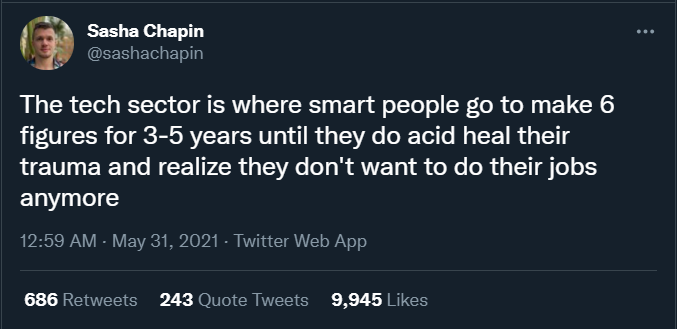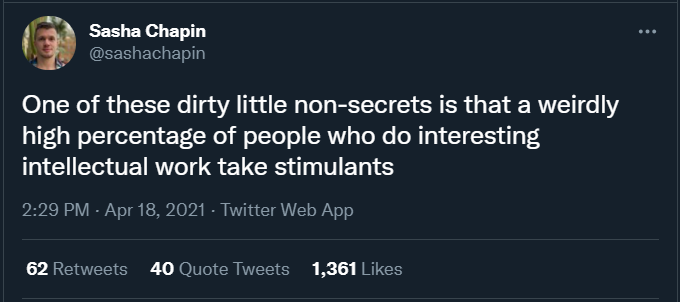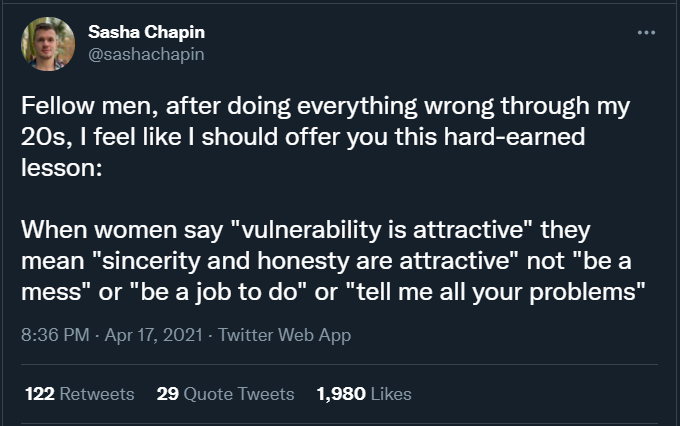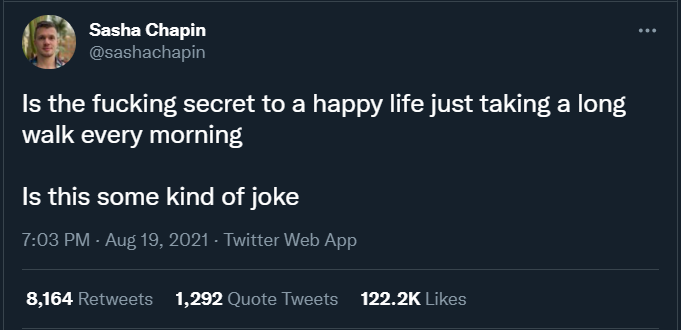Noobs Need Rules
post by Jacob Falkovich (Jacobian) · 2022-04-02T17:56:08.236Z · LW · GW · 3 commentsContents
Concepts as Learning Shortcuts How to Crush it on Twitter Think Less None 3 comments
Cross-posted from Putanumonit.
If you ask someone who’s good at dating for dating advice they’ll often tell you to “just be yourself”. Since they themselves are good at dating, being themselves serves them well. But if your self isn’t good at dating, you should probably be less yourself and more like the self of one of those people who are good at dating.
Many such cases.
Here’s a general model I propose of how people learn most skills:
- At first, you can neither perform the skill or discriminate between good and bad performance.
- You learn concepts that allow you to discriminate, and explicit rules to guide your practice.
- As you keep improving, you recognize more and more rules even as the first ones you learned become intuitive and natural.
- At some point, your intuitive model is rich enough that imposing additional rules on top of it decreases performance, and you should stop consciously applying rules and do what is natural.
You learn explicit rules to attain competence, and you learn to break from the rules’ constraints to attain mastery.
Going through the stages for any worthwhile skill takes many years. Most people who are skilled at writing or basketball or office politics started practicing as little kids. When they say they never had to learn explicit rules, it often means that they were taught the rules so long ago they forgot. They often give advice like “don’t think too hard” or “do what comes naturally” because it’s the last thing they had to learn. But it’s terrible advice for beginners who need to learn the first things first. The point of learning explicit rules is so that “what comes naturally” is something that doesn’t suck.
When I learned how to coach tennis I (re)learned at once dozens of guidelines to impart to my students. But when I actually coached kids I would only instruct a student on one rule like “follow through over your opposite shoulder” at a time until the student would do it reliably (and thus, intuitively). Applying rules explicitly relies on type 2 thinking and working memory, which can hold no more than one “tennis rule” at once.
Type 2 thinking is also slow and effortful. Striking a tennis ball while also concentrating on a sentence-long rule is harder at first than merely swinging at a ball, so students often seem to do worse when they start learning things explicitly. But eventually they get better. Skillful execution depends on fast and fluid type 1 thinking, but that system is best trained with type 2 effort.
This applies to all kinds of domains. There’s this stereotype of nerds trying to learn explicit rules for social interactions from corny books, only to realize that this approach is doomed and finally finding success by “just vibing”. But I know a lot of nerds who credit these books with bringing them to the minimum level of social adeptness at which they could function and improve further. My own social standing improved dramatically after I read a blog post on “weirdness points [LW · GW]” in my late twenties!
If you’re a noob you don’t know how large the gap is between you and mastery, but if you’re a master you may have forgotten that as well. Noobs need rules!
Concepts as Learning Shortcuts
A very intriguing theory makes the case that explicit rules and concepts are necessary even for experiencing and perceiving what we think of as native emotions. The theory claims that, for example, “anger” is learned by little kids when their parents point out that “this shouting man there is angry” or tell them how “I got angry when the boss insulted me but I held my tongue”. If anger resulted from some hardwired circuit, the theory claims, we couldn’t explain why there is no bodily, facial, or neural signature that consistently identifies anger across different individuals who claim to be angry, or why we apply the term to such disparate behaviors as smashing plates in a rage and also to seething and plotting cold revenge.
I have a vague sense that this is related to general constraints on learning from unstructured data. There are some simple features of an environment that a brain can comprehend simply by observing the world and trying to predict the incoming inputs in a bootstrap learning process. More abstract and complex features, like the multivariate subtle differences between an excited person and an angry one, require exponentially more time and data to train on — unless you can use explicit concepts and rules to massively shortcut the process.
This would apply to AI as well. By simply learning statistical regularities in a massive pile of text, AI like GPT-3 can become perfect at placing letters (spelling), great at placing words (grammar), OK at placing sentences (logic), and terrible at connecting paragraphs into a meaningful text. As a human, I feel like I can also complete sentences on a random topic on mental autopilot (“Jenny entered the grocery store and…”) but to string paragraphs together into a blog post I actually need to know what concepts I’m talking about. This is quite speculative, but if this model is correct I predict that GPT-4 will be even better at writing the sort of strung-together essays an indifferent high-schooler submits in class but won’t start producing writing that a reader who’s paying attention [LW · GW] will find meaningful.
How to Crush it on Twitter
Speaking of writing, this post was prompted by Sasha Chapin’s post How to Crush it on Twitter When You Don’t Want to Do That. Sasha only gives a few pointers, one of them is:
Think Less
All of the tweets I do that perform really well have one thing in common. Which is that I didn’t think about them too hard.
But of course, Sasha is a successful writer and writing coach. As for people who aren’t, they rarely produce perfectly crafted, viral tweets without trying. It takes many years of thinking hard to not have to think hard!
Since I believe in the utility of explicit rules more than Sasha, I took his challenge to dissect his own most successful tweets and extract useful rules for Twitter noobs.

https://twitter.com/sashachapin/status/1399229028121288706
Rule 1 — Storytelling
This tweet is great because it tells a clear narrative, building suspense and resolving in a twist. If Sasha had shifted the order to “People often realize they don’t want to do their jobs anymore after they take acid and heal their trauma. This happens after they make 6 figures for 3-5 years in the tech sector.” the tweet would have failed by placing the punchline about jobs at the beginning which would make the rest merely superfluous detail.
Rule 2 — Non-partisanship
How does Sasha feel about the acidified techies? He’s neither obviously mocking them nor identifying with them. So much of Twitter is banal ingroup/outgroup sniping, which extends to techies and techie-haters. By avoiding identification with either group Sasha invites the reader to focus on the story instead of on scoring points for a team.
Rule 3 — Goldilocks specificity
The specific numbers (6 figures, 3-5 years) may seem dispensable but they help establish the tweet’s specificity at some indeterminate level between a sweeping generalization of all techies and the story of just one friend of the author. As with the non-partisanship, this flexibility of interpretation invites the reader to engage. A good tweet has one strong point but leaves everything aside from it up to the reader.

https://twitter.com/sashachapin/status/1383850151349940225
Rule 4 — Debate bait
Another tweet that optimized for engagement by bringing up a point without otherwise committing to a position. What’s a “weirdly high” percentage? Is this a secret or not? What counts as “stimulants”? This tweet invites everyone to share their stimulant story in the QTs, while also imagining that Sasha agrees with them because he refrained from expressing a moral stance.

https://twitter.com/sashachapin/status/1383580156766294016
Rule 5 — Tweet about Dating and Relationships
Bitches love tweets about dating and relationships.

Rule 6 — Cross out the Wrong Words
As Mark Twain said (or not), crossing out the wrong words is all it takes to write well. Sasha’s most viral tweet is also his best, and its quality lies in the economy of words.
It scans like a poem with the brevity of words, lack of punctuation, and the parallel “Is th” that starts each line. Like Sasha’s other tweets, it makes a single point (walking every morning made Sasha happy) without elaborating too much. “Is this some kind of joke” communicates a complex sentiment of elation mixed with exasperation without having to talk about the sentiment by adding filler like “I feel that…”
There are many ways to write this tweet in a longer (and worse) way, but you can go over each word in it and not find a single one that would improve the tweet if it was removed. That’s the sign of a great piece of writing.
Rule 7 — Hone your style and forget the rules
This last tweet shares the style elements of the previous three: an observation that’s in the sweet spot between a trite navalism and a politically-charge hot take expressed without moralizing or punctuation. But it has a poetical beauty that can’t be achieved by merely following explicit rules. You couldn’t tweet it. I couldn’t tweet it. And I don’t think Sasha himself could’ve tweeted it even a few months ago.
Look at the timestamps of the tweets above and you’ll notice that the quality of Sasha’s best tweets and their popularity has increased from April to May to August. Sasha joined Twitter in 2014 and was even bluechecked for a while, but before 2021 he didn’t have a single tweet accumulate even 500 likes. Then he hit on a style that works with the “vulnerability is attractive” tweet and kept practicing that style for four months and hundreds of tweets until it became second nature. In August, his brain effortlessly produced the perfect “walking” tweet.
And so this brings us back to the main meta-rule: use explicit rules to attain basic competence, but once you glimpse real mastery you should be ready to abandon them and train your implicit model with practice and feedback. Just don’t forget where you came from.
3 comments
Comments sorted by top scores.
comment by Said Achmiz (SaidAchmiz) · 2022-04-02T19:17:07.311Z · LW(p) · GW(p)
A.K.A. “three levels of mastery”.
comment by mingyuan · 2022-04-03T05:21:59.362Z · LW(p) · GW(p)
This is awesome pedagogy advice and I am a terrible teacher. I've been good at writing for so long (like since before I can remember) that I still wouldn't really even know how to begin teaching someone to write. But I've been trying to teach someone guitar — a skill that I started learning at age 15, and so can remember various stages of being really terrible at — and I just keep being like "it's easy, I don't know, just do the thing I'm doing." Focusing on explicit rules is smart. Yeah. I should try that.
Also damn that tweet about vulnerability is spot-on. Well-articulated.
Too tired and addled to write a smarter comment than this but mostly just want to express appreciation for this post :)
comment by nim · 2022-04-03T03:34:20.063Z · LW(p) · GW(p)
A visual artist once explained a similar phenomenon to me, where one's ability to recognize quality work is always a step ahead one's ability to create things to that standard. They were explaining why they were so aware of room for improvement in their work even though it seemed great to me, a novice at their medium.
It sounds like the "just be yourself" advice might emerge when someone's ability to do the thing matches or exceeds their ability to recognize quality or excellence in the thing. I'm surprised that people who get to that point don't seem confused or frightened by their inability to articulate how they're getting their results.